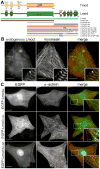Leiomodin is an actin filament nucleator in muscle cells
- PMID: 18403713
- PMCID: PMC2845909
- DOI: 10.1126/science.1155313
Leiomodin is an actin filament nucleator in muscle cells
Abstract
Initiation of actin polymerization in cells requires nucleation factors. Here we describe an actin-binding protein, leiomodin, that acted as a strong filament nucleator in muscle cells. Leiomodin shared two actin-binding sites with the filament pointed end-capping protein tropomodulin: a flexible N-terminal region and a leucine-rich repeat domain. Leiomodin also contained a C-terminal extension of 150 residues. The smallest fragment with strong nucleation activity included the leucine-rich repeat and C-terminal extension. The N-terminal region enhanced the nucleation activity threefold and recruited tropomyosin, which weakly stimulated nucleation and mediated localization of leiomodin to the middle of muscle sarcomeres. Knocking down leiomodin severely compromised sarcomere assembly in cultured muscle cells, which suggests a role for leiomodin in the nucleation of tropomyosin-decorated filaments in muscles.
Figures




Similar articles
-
Leiomodin creates a leaky cap at the pointed end of actin-thin filaments.PLoS Biol. 2020 Sep 8;18(9):e3000848. doi: 10.1371/journal.pbio.3000848. eCollection 2020 Sep. PLoS Biol. 2020. Update in: PLoS Biol. 2025 Jan 30;23(1):e3003027. doi: 10.1371/journal.pbio.3003027. PMID: 32898131 Free PMC article. Updated.
-
The N-terminal tropomyosin- and actin-binding sites are important for leiomodin 2's function.Mol Biol Cell. 2016 Aug 15;27(16):2565-75. doi: 10.1091/mbc.E16-03-0200. Epub 2016 Jun 15. Mol Biol Cell. 2016. PMID: 27307584 Free PMC article.
-
Different localizations and cellular behaviors of leiomodin and tropomodulin in mature cardiomyocyte sarcomeres.Mol Biol Cell. 2010 Oct 1;21(19):3352-61. doi: 10.1091/mbc.E10-02-0109. Epub 2010 Aug 4. Mol Biol Cell. 2010. PMID: 20685966 Free PMC article.
-
Tropomodulin capping of actin filaments in striated muscle development and physiology.J Biomed Biotechnol. 2011;2011:103069. doi: 10.1155/2011/103069. Epub 2011 Oct 17. J Biomed Biotechnol. 2011. PMID: 22013379 Free PMC article. Review.
-
The role of leiomodin in actin dynamics: a new road or a secret gate.FEBS J. 2022 Oct;289(20):6119-6131. doi: 10.1111/febs.16128. Epub 2021 Jul 26. FEBS J. 2022. PMID: 34273242 Free PMC article. Review.
Cited by
-
Tropomodulins: pointed-end capping proteins that regulate actin filament architecture in diverse cell types.Cytoskeleton (Hoboken). 2012 Jun;69(6):337-70. doi: 10.1002/cm.21031. Epub 2012 May 4. Cytoskeleton (Hoboken). 2012. PMID: 22488942 Free PMC article. Review.
-
Exploring protein relative relations in skeletal muscle proteomic analysis for insights into insulin resistance and type 2 diabetes.Sci Rep. 2024 Jul 31;14(1):17631. doi: 10.1038/s41598-024-68568-4. Sci Rep. 2024. PMID: 39085321 Free PMC article.
-
LMOD2-related dilated cardiomyopathy presenting in late infancy.Am J Med Genet A. 2022 Jun;188(6):1858-1862. doi: 10.1002/ajmg.a.62699. Epub 2022 Feb 21. Am J Med Genet A. 2022. PMID: 35188328 Free PMC article.
-
Anti-remodeling and anti-fibrotic effects of the neuregulin-1β glial growth factor 2 in a large animal model of heart failure.J Am Heart Assoc. 2014 Oct 23;3(5):e000773. doi: 10.1161/JAHA.113.000773. J Am Heart Assoc. 2014. PMID: 25341890 Free PMC article.
-
Leiomodin 3 and tropomodulin 4 have overlapping functions during skeletal myofibrillogenesis.J Cell Sci. 2015 Jan 15;128(2):239-50. doi: 10.1242/jcs.152702. Epub 2014 Nov 27. J Cell Sci. 2015. PMID: 25431137 Free PMC article.
References
Publication types
MeSH terms
Substances
Grants and funding
LinkOut - more resources
Full Text Sources
Other Literature Sources
Molecular Biology Databases

